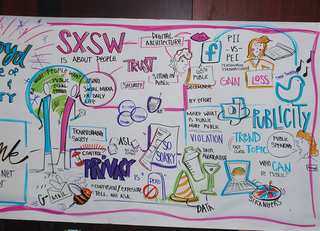
By Elizabeth Leddy
Although it might not be known for its selection of technical talks and speakers, this years SXSW Interactive (SXSWi) delivered a variety of material across a broad spectrum of web and social media technology. Austin, Texas, continued to be the perfect destination for more parties, people, and shenanigans than ever. Despite problems with aggressive sponsorship and self-promoters, an open mind and open agenda made it possible to enjoy this classic tech conference.
As expected, the talk scene was ripe with material for designers and user interface fanatics. Unfortunately for hardcore developers, the schedule of talks was not unlike a satellite TV listing - hundreds of channels and nothing to watch. Nevertheless, this year was significantly better than in the past.
Deep dives into prototyping with JavaScript, HTML5, web frameworks, and Objective C, among others, were welcomed by many and helped justify the (quickly rising) cost of the trip to generous employers. Frequent conference goers, however, would still not be satisfied with the technical level of the content presented.
A pleasant surprise this year was the addition of talks about social responsibility from speakers like Jaron Lanier and Douglas Rushkoff. Their more critical perspective of social media and it's effects on the next generation were a welcome break for those who have become tired of the relentless Web 2.0 fanaticism that tends to dominate the conference.
The speaker selection process for SXSWi is continually changing, and this year, talks were selected by the people instead of a committee. This popularity contest meant that the quality of talks was extremely unpredictable. It was not uncommon to see a keynote speaker bonk or an unknown captivate and enthrall a small audience of listeners. The primary assailant in this situation was a bad case of panelist-itis. SXSW would do good by its attendees next year if it limited the number of panels and went back to a more traditional speaker format.
That said, no one comes to SXSWi to listen to the talks anyway. They are really just background noise for eight hours of email checking, snarky twitter comments, blogging, and location-based stalking. The real SXSWi starts at 6pm, when the convention center explodes with entrepreneurs, UI designers, developers, and everything in between. As the sun sets, booze starts flowing freely and music replaces the rhythm of thousands of fingers on keyboards.
Many people say that the nighttime happenings are all about networking. They can be, especially if you and your new acquaintances can remain sober enough to remember what you talked about. In reality, it's the perfect time to talk with people who work on the other end of the spectrum.
Back-end developers interact with usability experts and discuss the pain they cause each other. Workflow experts debate with platform architects about when technology is the solution and when it just aggravates deeper problems. These are the core conversations that happen when you unite so many different users and creators of the web and social media in the playground of Austin.
And what a playground it is. Austin explodes with creativity, excitement, and possibility at this time of the year. At more than 14,000 registered attendees, this year's SXSWi was the biggest to date - bigger than the SXSW music and film portions. The organizers did a great job at handling the masses by opening up hotels across the bridge and creating several shuttle-based services. It's hard to think of a city better equipped to handle the mass crowds of uncontrollable and often intoxicated technocrats.
The sheer size of the conference can be a big deterrent to repeat festival goers. This is especially true if you stick to the main party scene - long lines, obnoxious cameras, and expensive tabs dominated the official parties. However, getting off the main party drag and opening up to unexpected situations allowed Austin to deliver experiences difficult to imagine.
Not many times in your life can you ride a seven-person bike decorated like a snake at midnight, hop in the back of an ice cream truck to hitch a ride downtown, or find yourself in an Enchanted Forest or at a spontaneous dance party in the revolving doors of the Hilton. If it sounds like an acid trip, chances are it happened at SXSWi.
On the other end of the happiness spectrum, the festival has become so big that it's hard to walk anywhere without being pitched a product or having schwag shoved in your face. Attendees and social media "experts" psychotically documented every moment in pictures, video, and text, with no respect for privacy or content: If it wasn't documented, it probably didn't happen. The inability to enjoy that which makes SXSWi so unique continues to be a problem that conference organizers must address next year if they want to retain repeat attendees.
Although it has some obvious shortcomings, SXSWi remains a conference to be reckoned with. The lack of technical content won't have it replacing OSCON or SCALE any time soon, but those who are excited to explore the interdisciplinary nature of the web and social media will feel right at home in Austin for many years to come.